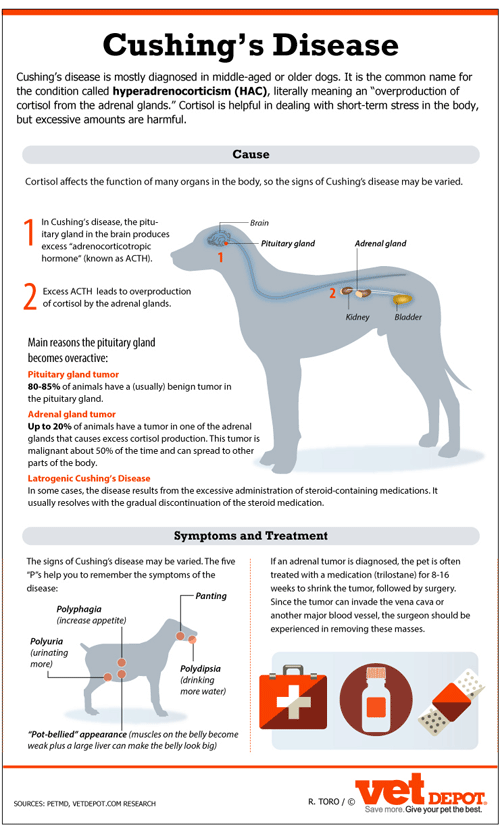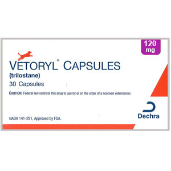Cushing's disease was named in 1932 for Harvey Cushing, a human neurosurgeon. It is the common name for the condition called hyperadrenocorticism (HAC), literally meaning an "overproduction of cortisol from the adrenal glands." Cortisol is helpful in dealing with short term stress in the body, but excessive amounts are harmful.
Which Animals are Affected?

Cushing's disease is mostly diagnosed in middle-aged or older dogs. It can affect any breed, but is seen most frequently in Poodles, Dachshunds, Terriers, German Shepherd Dogs, Beagles, and Labrador Retrievers.
What is the Underlying Cause?
In the normal animal, the pituitary gland in the brain produces a substance called "adrenocorticotropic hormone" (known as ACTH). This hormone stimulates the adrenal glands to produce cortisol. There is a feedback mechanism between the adrenal gland, the pituitary gland, and the hypothalamus (another part of the brain) that recognizes when there is enough cortisol in the body and when more is needed. This regulates how much ACTH and ultimately cortisol is produced.
"Cushing's disease is a slowly progressive disease (over months to years) and treatment is life-long."
Cushing's disease results when the pituitary gland in the brain produces excess ACTH regardless of the feedback mechanism, leading to excess production of cortisol by the adrenal glands. There are two main reasons the pituitary gland becomes overactive:
- Pituitary gland tumor - 80-85% of animals have a (usually) benign tumor in the pituitary gland.
- Adrenal gland tumor - up to 20% of animals have a tumor in one of the adrenal glands that causes excess cortisol production. This tumor is malignant about 50% of the time and can spread to other parts of the body.
In some cases, the disease results from the excessive administration of steroid-containing medications. This is called "Iatrogenic Cushing's Disease." It usually resolves with the gradual discontinuation of the steroid medication.
What are the Symptoms of Cushing's Disease?
The five "P"s help you to remember the signs of Cushing's disease:
- Polydipsia - drinking more water
- Polyuria - urinating more
- Polyphagia - increase appetite
- Panting
- "Pot-bellied" appearance - muscles on the belly become weak plus a large liver can make the belly look big
Dermatological changes such as thin skin, comedones (blackheads), hyperpigmentation (darkening of the skin), and infections are common. Hair loss is often seen and may be symmetrical. Urinary tract infections may also be a recurring problem. Other less common symptoms include neurologic signs, reproductive failure, and thromboembolic disease (throwing blood clots).
How is Cushing's Disease Diagnosed?
Diagnosis gets complicated. The type of animal, symptoms, and physical examination findings will often put this disease on the rule-out list, but laboratory testing is necessary for diagnosis. A blood chemistry panel will usually show an increased ALP (alkaline phosphatase, an enzyme produced by the liver); the urine will likely be dilute and contain an excessive amount of protein, but these findings are not consistent or diagnostic for this disease. More specific adrenal function testing is necessary to diagnose Cushing's. Unfortunately, none of the available tests are 100% accurate, necessitating multiple tests or repeated testing, which can be costly.
A urine cortisol to creatinine ratio is a good screening test that is fairly inexpensive. If normal, this test can rule-out Cushing's as a diagnosis, but other diseases can also result in abnormal results. To confirm the diagnosis, a different test must be run.
The most common and least expensive test is the low-dose dexamethasone suppression test (LDDS). A blood sample is drawn to measure cortisol, dexamethasone is administered, and blood cortisol levels are measured four and eight hours post-dexamethasone administration. In a normal dog, the dexamethasone should inhibit pituitary secretion of ACTH, causing a decrease in cortisol. In the cushingoid dog, cortisol is not suppressed.
It is important to determine where the tumor causing Cushing's disease is located so the best treatment can be given. An x-ray, ultrasound, CT scan, or MRI usually identifies an adrenal tumor. Several blood tests may be indicated to confirm a pituitary tumor.
Should the Disease Always be Treated?
The short answer is no. Cushing's disease is a slowly progressive disease (over months to years) and treatment is life-long. The owner should be educated to know how to monitor for symptoms that indicate the disease is progressing and in need of treatment. Regular monitoring by a veterinarian is crucial to detect developing problems and should include blood pressure checks, urinalysis (for infections), and urine protein concentration.
Typically treatment is started when symptoms are present that are potentially dangerous or bothersome to the pet or owner, including:
- Excessive drinking or urinating
- Nocturia - owner has to get up during night to let dog out to urinate
- Excessive panting
- Recurrent skin infections
- Recurrent urinary tract infections
Abnormal physical exam findings or laboratory abnormalities that may prompt treatment include:
- Hypertension (high blood pressure) that doesn't improve with standard treatment
- Recurrent skin or urinary tract infections
- Progressive proteinuria (increasing amount of protein lost in urine) that indicates worsening kidney damage
If there are no symptoms or if the dog's symptoms are mild, treatment is not yet warranted. Regular and thorough monitoring is recommended.
What can Happen if Cushing's is Not Treated?
Severe consequences of not treating mild Cushing's disease are usually rare and include:
- Diabetes mellitus (Miniature Schnauzers are especially prone to getting diabetes, so should be treated earlier than other breeds)
- Ruptured cranial cruciate ligament (equivalent to a torn ACL in humans)
How is Cushing's Disease Treated?
If an adrenal tumor is diagnosed, the pet is often treated with a medication (trilostane) for 8-16 weeks to shrink the tumor, followed by surgery. Since the tumor can invade the vena cava or another major blood vessel, the surgeon should be experienced in removing these masses.

Because pituitary tumors are usually inoperable due to their location, oral medication is given to suppress the production of cortisol. The two drugs used most often are mitotane and trilostane. Each drug has potentially serious complications and should be discussed with the owner prior to being started.
Dogs on trilostane or mitotane should be monitored using a test called an ACTH-stimulation test to determine if the right dose of medication is being used. The test is fairly expensive and should be conducted every 6 months and after each dosage adjustment.
Prognosis
Most dogs with Cushing's disease will eventually require treatment, but can live comfortably for several years. The mean life expectancy for a dog with an appropriately treated adrenal tumor is 36 months; for a pituitary tumor it is 30 months.
Sources
Ward, C.R. (2013). Canine and Feline Cushing's Disease. Presented at the American College of Veterinary Internal Medicine (ACVIM) Conference, Athens, GA
Laura V. Lane, Theresa E. Rizzi. Low-Dose Dexamethasone Suppression Testing for Hyperadrenocorticism. Clinicians Brief. October 2010; 69-73.
DeVictoria, T. (2012). Cushing's Disease - What Is Really Happening in There? Presented at the Atlantic Coast Veterinary Conference, Princeton, NJ
The above is provided for information purposes only and should not be used for the diagnosis or treatment of any condition.
This information does not cover all possible variables, conditions, reactions, or risks relating to any topic, medication, or product and should not
be considered complete. Certain products or medications may have risks and you should always consult your local veterinarian concerning the treatment of
your pet. Any trademarks are the property of their respective owners.